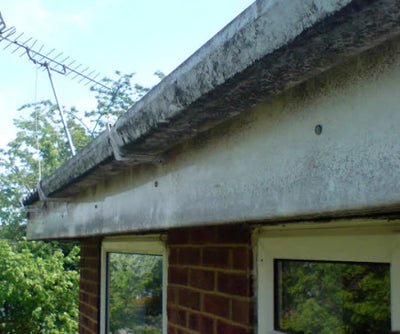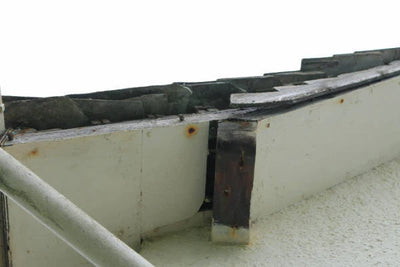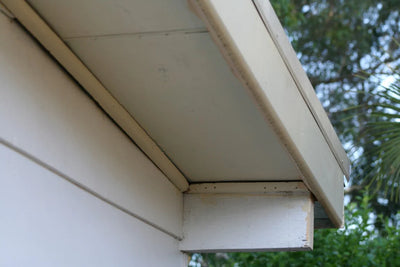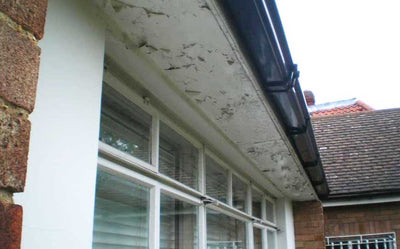Asbestos Soffits - How To Identify & Work With Them



Written by Tom Yates . Edited 8th December 2023
Fact Checked by William Wright, NEBOSH
Overview
Asbestos soffits were widely used between the 1970s and 1990s and if your house was built before 1999, there is a possibility that it could have asbestos soffits. These under-fitted boards were either made from AIB or asbestos cement and can pose a health risk if the asbestos fibres become airborne.
In the below guide, I explain everything there is to know about asbestos soffits so you are armed with knowledge and can act if needed.
What do asbestos soffits look like?
Like most asbestos-containing materials, asbestos soffits are indistinguishable from soffits which do not contain asbestos. They can often resemble wood and can be painted so there's no particular colour to look out for. Asbestos soffits come in 2 variants: cement board & insulation board, the latter being the higher risk of the 2. asbestos cement soffits will be thinner and brittle, where as AIB/Insulation board soffits will be thicker and more fibrous.
They are often a white/grey colour and you may notice white spores or discolouration on the panels.
There's only one way of knowing for sure if the soffits you're looking at contain asbestos, and that is to have the board tested in a laboratory. If the building was built before 1999 and you spot some non-plastic soffit boarding, it is recommended that you assume that they could potentially contain asbestos.




Fact Sheet
Identifying asbestos soffits
Here are some frequently asked questions regarding identifying asbestos soffits, if you have any questions which we've missed in this article please contact us and one of our asbestos specialists will respond to your question.
How thick are asbestos soffits?
+
-
Cement soffits are usually thin and brittle, where as AIB soffits are thick and fibrous. (Do not attempt to break the soffit without wearing PPE for working with asbestos)
Can PVC soffits contain asbestos?
+
-
No, PVC soffits are a newer plastic material which never contained asbestos. Just be careful that PVC soffits haven't been clad over the old asbestos-containing ones.
How are they affixed?
+
-
The soffit boards are usually nailed/screwed to wooden battens supporting the soffit boards.
Where are they commonly found?
Asbestos soffits are found under the roofing line of your property, they usually go all the way around the house and your guttering is usually attached to them.
How dangerous are asbestos soffits?
Asbestos soffits made using insulation board / AIB are considered a high-risk asbestos-containing material due to its friable nature, on the other hand, asbestos cement soffits are considered a lower-risk asbestos-containing product. This is due to the material makeup. With the material being heavily bonded and non-friable (Friability is the tendency to break down, chip or crumble under pressure or as a result of abrasion) this means when the product is disturbed or broken there is a minimal release of asbestos fibres.
Whilst cement soffits are considered lower-risk by the HSE (Health & Safety Executive)[1]this doesn't mean that the product isn't harmful and certainly doesn't mean it is safe to remove without protection. If you intend to work on asbestos cement soffits then ensure you wear appropriate RPE & PPE. If your soffits are made from AIB then its important you instruct a licensed asbestos removal company to do any removal works for you. A DIY job is not advised.
The facts about asbestos exposure
Asbestos exposure can lead to diseases such as asbestosis, lung cancer, and mesothelioma. These diseases often have a long latency period, meaning symptoms may not manifest until many years after exposure.

Tom Yates
03/01/2023

Is a license required for removal?
According to the HSE an asbestos license is not required to remove cement boarding. However, Insulation board soffits are licensable and notifiable which means the contractor removing them will need a full asbestos license issued by the HSE and will also need to notify the HSE 2 weeks before any removal works can commence.
Asbestos soffits statistics in the UK
We carry out thousands of tests per year, and as such we have accumulated an extensive data set that we can call upon. According to our data around 14% of the samples we test are insulation board samples which includes AIB soffits - This makes soffits potentially the 2nd most tested material. Of those tested, 32% of insulation board samples came back with a positive result (containing asbestos).
If we are to generalise this data we could assume that if you find an insulation board soffit on your house there is a 32% chance that it contains asbestos. Unfortunately in our data insulation board samples are grouped together and don't specifically relate to soffits.
Of those tested, 32% of insulation board came back with a positive result.
(Results from samples sent to Asbestos Sampling in 2023)
Frequently Asked Questions
Do You Need A License To Remove Asbestos Soffits?
+
-
Yes, A license may be required to remove asbestos soffits if made from AIB - The works may also be notifiable to the HSE.
Can I Remove Them Myself?
+
-
If you are the owner of the property and it is classed as a domestic dwelling then there are no laws preventing you from removing the soffits yourself, however, we would always recommend instructing professionals to carry out any removal works for you to protect your health.
If you are an employee or the property is classed as non-domestic or commercial then you are bound by the laws of the HSE. You may be able to remove them yourself providing you have relevant training and experience in doing so. It's worth checking the HSE guidance on this to ensure you're not contravening any health & safety laws.
Can You Cover Over Asbestos Soffits?
+
-
Potentially. Whilst we would always recommend having them removed by professionals, some property owners would prefer to save the expense and simply cover the soffits up with new material. However, if you need to screw or nail into the old asbestos soffits to affix the new ones then this would disturb the asbestos soffits and cause a release of asbestos fibres. So we advise against this option.
Can you Seal / Encapsulate Asbestos Soffits?
+
-
If your soffits are in good condition and not deteriorating then you could have them encapsualted by an asbestos removal company. This can help maintain the soffits and prevent further weathering.
However, if you need to disturb the soffits then encapsulation isn't going to help.
How To Dispose Of Asbestos Soffits?
+
-
To dispose of asbestos in line with legislation the boarding should be bagged up using UN-certified asbestos waste bags. The material should be first put into the red bag which is then sealed using heavy-duty tape to create an air-tight seal. The clear bag should then be placed inside the red bag and again sealed with tape. This technique is called double-bagging. These bags can then be taken to the hazardous waste skip at a local waste recycling facility.
If the soffits are AIB then you would need an asbestos removal company
References / Citations
Quick Links
Full PPE Included
Full Asbestos Testing Kit
Test for asbestos yourself using one of our kits
- Results within 24hrs
- Tested at UKAS Accredited Lab
- Instructions & PPE Included
Want to learn more?
He's some other interesting articles we've written:
What is AIB / Asbestos Insulation Board
Get an Asbestos Removal Quote
How Much Does Asbestos Cost To Remove?


